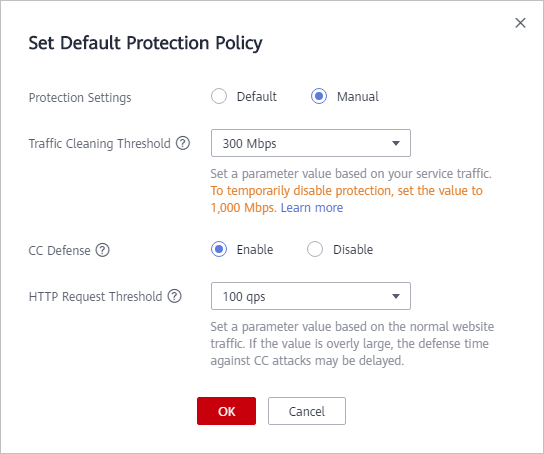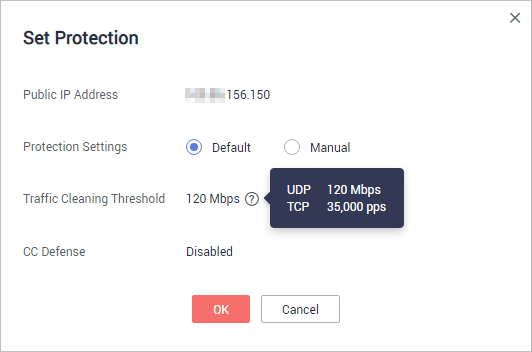Updated on 2025-08-01 GMT+08:00
How to Use Anti-DDoS
Description:
- Enable Anti-DDoS to defend IP addresses against DDoS attacks.
- Anti-DDoS can automatically enable the protection
- Before purchasing a public IP address, you can log in to the Anti-DDoS management console and click Set Default Protection Policy on the Public IP Addresses tab page to set the default protection policy for the new public IP address. After you purchase a public IP address, the default protection policy you have set will apply to the IP address.
Figure 1 Setting a default protection policy for newly purchased public IP addresses

- If you do not set a default protection policy for the newly purchased public IP addresses, the Protection Settings in Default mode apply to the IP addresses, as shown in Figure 2.
Default for Protection Settings: When the service User Datagram Protocol (UDP) traffic is greater than 120 Mbit/s or the Transmission Control Protocol (TCP) traffic is greater than 35,000 pps, traffic scrubbing is triggered and Anti-DDoS will automatically intercept the attack traffic.

- Mbps = Mbit/s (short for 1,000,000 bit/s). It is a unit of transmission rate and refers to the number of bits transmitted per second.
- PPS, short for Packets Per Second, is a measure of throughput for network devices. It means the number of packets sent per second.
- If you delete a public IP address, Anti-DDoS automatically disables the protection for the IP address, which is recorded in Cloud Trace Service (CTS).
- Enable alarm notification, which sends notifications by SMS or email when an IP address is under a DDoS attack.
- Adjust the defense policy based on service needs during defense.
- View monitoring and interception reports after the defense is enabled to check network security situations.
- You are not allowed to disable Anti-DDoS after it has been enabled.
Parent topic: Accessing and Using Anti-DDoS
Feedback
Was this page helpful?
Provide feedbackThank you very much for your feedback. We will continue working to improve the documentation.See the reply and handling status in My Cloud VOC.
The system is busy. Please try again later.
For any further questions, feel free to contact us through the chatbot.
Chatbot






